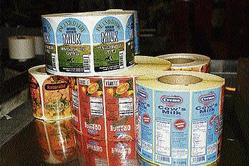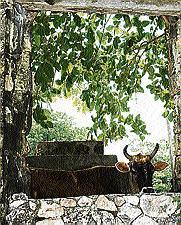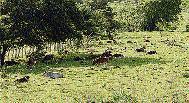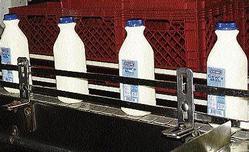
Milk and juices are produced at Island Dairies. - photos by Rosemary ParkinsonRosemary Parkinson, Contributor
The use of milk began with the domestication of animals in areas now known as Iran and Afghanistan in about 9000 BC. By 7000 BC cattle were being herded in Turkey and parts of Africa for the sole purpose of milking. The Greeks and Romans started methods for making cheese from milk, and the making of these products spread throughout Europe.
Much later in 1884 one Dr. Henry Thatcher upset aboutthe delivery of milk in open buckets, invented the milk bottle. By 1863 Frenchman Louis Pasteur developed a method of heating wine to kill the micro organisms that cause it to turn into vinegar. Known as pasteurisation, milk would soon follow this path. By 1889, Thatcher's Common Sense Milk Jar filled with milk, sealed with a waxed paper disc pressed into a groove inside the bottle's neck was born. A new era in milk delivery developed until waxed paper cartons came into being.
Up to 1995 when I lived in Warwickshire, the milkman was still delivering fresh milk in those old time bottles. There was nothing sweeter than scooping the extra cream off the top once in the kitchen! There's no doubt this milk, untouched by wax, tastes different.
Dairy cows

A bull looks over the old wall of the Llandovery Estate.
Milk is obtained from dairy cows, goats, water buffalo and even reindeer; the liquid making butter, cream, yogurt, cheese and a myriad of other products. In Jamaica most of the milk produced is from dairy cows as water buffalo and reindeer are not to be seen not that I know of anyhow!
Goat milk is, however, becoming a delightful substitute and with those who see the niche - goat rearing goats is increasing - an important base for the making of feta cheese and yogurt. If only more people would realise the potential of a goat beyond the thought of curry, perhaps there would not be so many stray ones hampering cars on the highway and making a mess of already unsightly rubbish dumps!
Jamaica Hope Cattle

Cows grazing in the open fields in St. Ann.
About 50 years ago, Jamaican scientist Dr. Thomas Lecky developed the Jamaica Hope, a breed of tropical dairy cattle - a combination of the British Jersey cow (small and light feeding), the Holstein (heavy milk producers) and the Indian Sahiwal (disease resistant and adapted to the tropics). The Hope cattle can produce an average of 12 litres of milk per day - three times the amount produced by other cattle on the island. Bearing in mind the difficult foraging conditions, it can feed on marginal pasture lands in hot, humid conditions producing a good quantity of milk. However, inexpensive powdered milk imports have led to small farmers giving up breeding cattle for milking. With the advent of the interest worldwide in agri-tourism; and that of the Caribbean on increasing our agriculture to curtail imports and feed ourselves, it would be opportune for the authorities to aid cattle farmers in every way possible; hopefully encouraging more cattle rearing. Would it not be wonderful to have fresh milk delivered to your doorstep daily? Why must these simple things be but a mere pipe dream?
Milk Facts

Milk coming off the line.
While many people have lactose intolerance, some in the know argue that this is because of the pasteurisation and homogenisation of milk claiming the process kills bacteria but also particles of the milk, creating the inability of the body to assimilate the sugars or lactose in same. Nowadays, those who suffer from this phenomena and are also vegetarian, do not drink fresh milk are convinced that milk is not good for you. Should soya milk take its place? I say: "Sorry guys! But soya does not cut it for me either by the glass or in any recipe."
Fun milk facts:
1. A cow must be a mother before it can give up milk.
2. An average well-fed cow will give up eight gallons a day or 90 glasses of milk.
3. It takes 12 pounds of milk to make one gallon of ice cream and 10 pounds to make one pound of cheese.
4. Whole milk comes in 3.5 per cent milk fat. Low fat milk in two per cent or one per cent. Skim milk is a non-fat milk but is the most nutrient dense.
5. Children one-two years old require some three servings of milk dairy products such as milk, yoghurt or cheese daily. Adults two servings per day.
6. Milk contains casein, a protein rich in calcium, the cream has the fat. These two factors make milk white in colour. Low fat and non-fat milk appear less white because they have less fat or cream.
7. While milk can be frozen it is not recommended as the quality is affected.
8. Pasteurised milk kills germs, homogenised forces the cream and the water not to separate. Pasteurised and homogenised full cream milk are fortified with Vitamin D, while low fat and skim are fortified with Vitamin A.
9. The calcium and vitamin D in milk makes for strong bones and teeth, helping build strong muscles. Eight ounces of milk daily gives 17 per cent protein, 29 per cent calcium, 23 per cent phosphorous, 23 per cent riboflavin, 25 per cent Vitamin D, and 15 per cent Vitamin B12.
Island Dairies and La Bella Italia Jamaica Ice Cream.
Island Dairies Ltd. in Priory, St. Ann was established in 1982 taking over from the defunct Shaw Park Dairies. The Gnam family saw Island Dairies as an opportunity to produce fresh milk products and to provide much required employment in the St. Ann's area. Llandovery Farms was purchased and that's where the bulk of the milk used in the production of their Island Dairy Milk and Cremo comes from. Both labels carry flavoured milks such as chocolate, eggnog, and cherry with a line of ice cream.
Boxed drinks essential for washing down a patty sandwiched in coco bread are also produced obviously helping in the costs involved to keep the milk side of the plant working. I spoke with Dr. Valerio Ferrari of La Bella Italia who began his ice cream concern in a small 'hut' in Negril. He spread his wings with both full cream, no-fat and no-sugar ice creams islandwide. This young entrepreneur would like desperately to use local fresh milk for his product.
"I have tried and cannot find one farmer, or one company, that can give me the quantity I need to keep up production. I cannot change from milk to powdered milk when milk is not available, or the taste of my ice cream will change. I would love to have fresh milk - just send me the person who can deliver and I will use it!"
Milk thoughts I would say.
Rosemary Parkinson was last seen chasing cows through St. Ann an empty bottle in hand.

